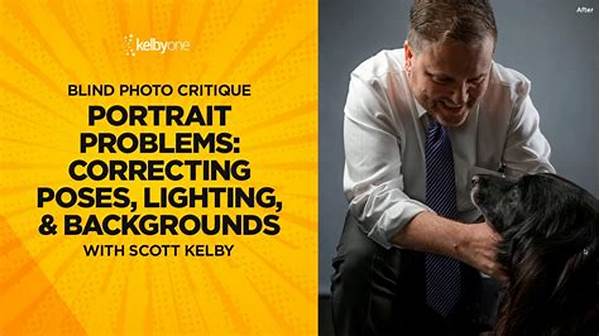Hey there, photography enthusiasts! Have you ever snapped what you thought was the perfect portrait shot, only to zoom in and find your subject’s face slightly blurry? Yep, that’s the pesky autofocus problem we’re diving into today! Join me as we unravel the mysteries of autofocus troubles and how to fix them to get those crystal-clear portraits every time.
Read Now : Principles Of Effective Negative Space
Understanding the Basics of Autofocus
Understanding autofocus can seem like deciphering a foreign language, but it’s crucial for correcting portrait autofocus problems. Your camera’s autofocus is basically the feature that detects and focuses on your subject, ensuring clarity and sharpness. Sometimes, it might focus on the wrong object altogether. This could be due to various reasons such as low light, busy backgrounds, or simply the camera not reading the scene correctly.
Let’s say you’re shooting a friend against a bustling street backdrop. Your camera might get a bit overzealous and focus on the street signs instead of your friend’s face. Frustrating, right? One way to tackle this is by using single-point autofocus, where you can pinpoint exactly where you want the camera to focus. Additionally, good lighting can snappily solve these issues. Less light equals more struggle for your autofocus to read scenes accurately.
So, try employing these troubleshooting tips: pay heed to environmental aspects, adjust your settings, and don’t shy away from using manual focus when needed. Correcting portrait autofocus problems may require some trial and error, but that’s the fun of it!
Common Autofocus Challenges
1. Busy backgrounds often steal focus, making correcting portrait autofocus problems a constant battle.
2. Low light settings are notorious culprits in autofocus struggles.
3. Movement within the frame confuses the camera, leading to blurry portraits.
4. Tiny features can befuddle autofocus, demanding manual adjustments.
5. Certain lenses may not autofocus well, prompting hardware reassessment.
Techniques to Improve Autofocus Accuracy
Correcting portrait autofocus problems requires a bit of technique finesse. First off, consider switching to Continuous or AI Servo focus mode when taking action-filled portraits. This setting helps the camera track movements more effectively, maintaining focus on the subject’s face even as they shift positions.
Additionally, getting familiar with your camera’s autofocus settings can do wonders. For instance, experimenting with focus points allows you to direct the camera’s attention more accurately. You might find it beneficial to reduce the number of focus points, thereby instructing the camera where exactly to concentrate its efforts. Also, never underestimate the importance of lighting. Ensuring your subject is well-lit can significantly enhance the autofocus performance.
Top 10 Tips for Ensuring Sharp Portrait Focus
1. Stable Posture: Keep steady while shooting.
2. Right Lens: Use a quality lens suitable for portraits.
3. Accurate Focus Point: Select the focus point manually.
4. Lighting: Ensure adequate lighting conditions.
5. Sensor Sensitivity: Adjust ISO for better autofocus.
Read Now : Comparison Of Free Apps For Image Watermarking
6. Professional Guidance: Attend workshops focused on autofocus.
7. Practice: Regular practice with different setups.
8. Software Updates: Keep your camera’s firmware updated.
9. Reverse Engineering: Review what went wrong post-shoot.
10. Assistance from Tech: Consider using tripods or remote shutters.
Corrective Strategies and Practical Steps
You might be wondering how to get those perfect portraits without the autofocus headache. Let’s chat about practical steps. First, equip yourself with a few corrective strategies geared towards correcting portrait autofocus problems. Delve into your camera settings; many cameras offer face-detection features, which primarily focus on human faces. Enabling this setting may reduce the chances of your autofocus messing it up.
Next, consider using back-button focusing, which can be a game-changer. By separating focus and shutter functions, you gain more control over when and where the focus is locked. It can prevent any last-second shifts in focus when you press the shutter. Combining these techniques with manual adjustments could just be the holy grail in tackling pesky autofocus issues.
Additionally, practice holding your camera properly. Poor hand stability often contributes to less accurate autofocusing. It’s all about finding a combination that works best with your composition style and the environments you usually shoot in. Correcting portrait autofocus problems involves discovering what suits your particular shooting preferences!
Beyond Autofocus: Enhancing Portrait Quality
Let’s not get too hung up on tech stuff. Correcting portrait autofocus problems isn’t just about fiddling with settings—it’s also about creativity and technique. Fool around with different compositions; sometimes, stepping slightly left or right can help the autofocus find its target more reliably. Remember to encourage your subjects to maintain relatively consistent positioning, limiting excessive head-bobbing which might confuse your camera.
Engage creatively with your subjects to evoke authentic expressions, because what’s the point of a sharp photo if the emotion isn’t captured perfectly? Use tools like reflectors to balance light, making your endeavor in correcting portrait autofocus problems a smoother journey. Flash spells can also aid to highlight contours, providing additional autofocusing references.
Wrapping It Up: Making Autofocus Work for You
In the quest for correcting portrait autofocus problems, patience is indeed a virtue. Experiment, learn from each photoshoot, and don’t be afraid to fail the first few times. Remember, photography is as much about the journey as it is about the destination. Each lesson learned contributes to your development as a sharper, smarter photographer.
Lastly, embrace post-processing magic. Tools like Adobe Lightroom help fix those minor focus flaws, making your portraits even more stunning. Ultimately, messy autofocus issues transform into terrific learning opportunities, encouraging growth and exploration. Keep at it, and don’t forget to enjoy the fantastic world of photography the whole way through!



